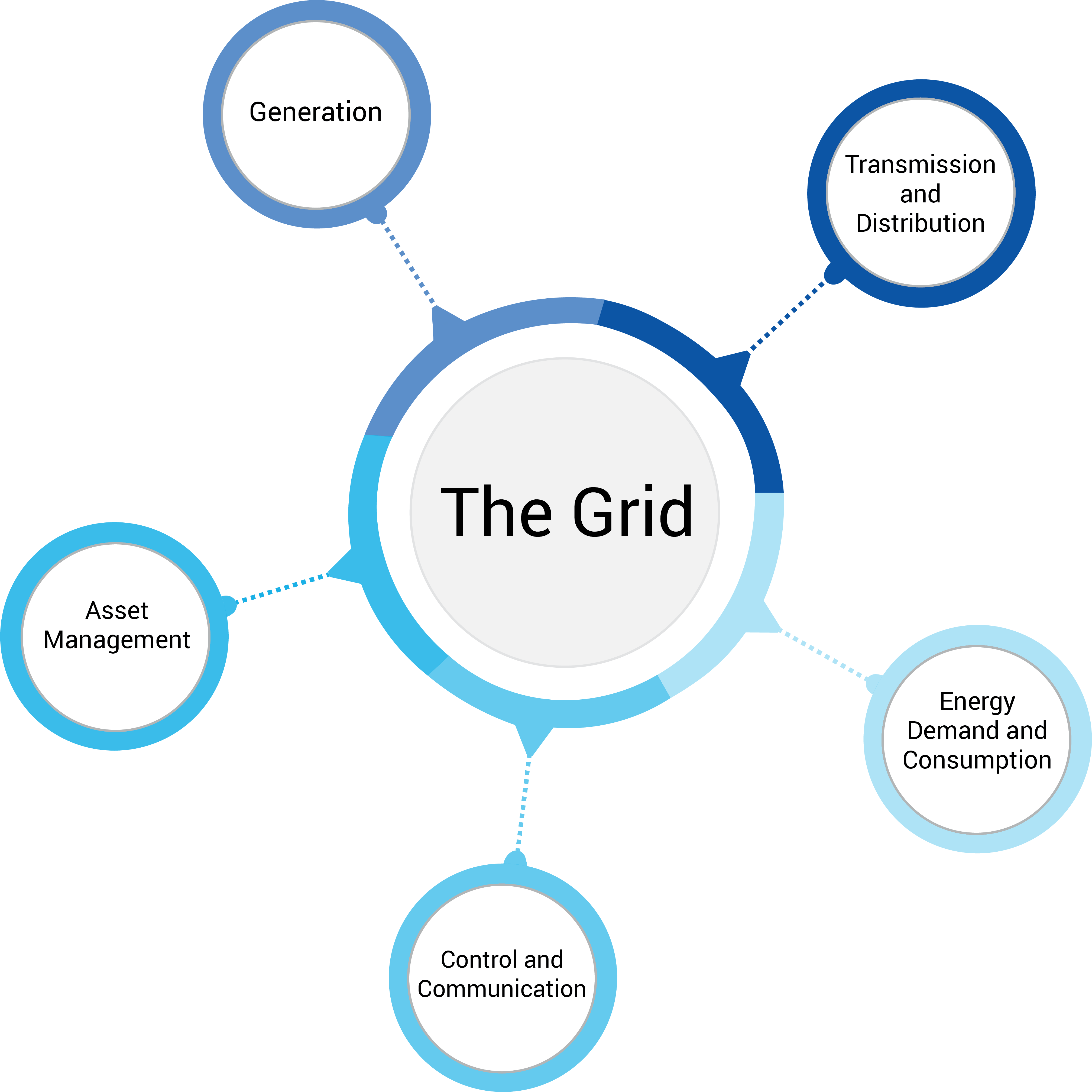Defining Grid Modernization

Innovation and Technology Driving Transformation and Modernization
The 2018 GridFWD conference, hosted by Smart Grid Northwest, convened around 250 energy service professionals in Vancouver, British Columbia. In a series of articles, Cadmus presents some key themes that emerged regarding grid modernization and the different pathways, priorities, and solutions discussed as next steps in moving this process forward.
By Jennifer Huckett, Ph.D.
The existing electrical grid, which has been developing since the early 1900s, is being transformed and modernized by innovative approaches and technologies. Grid modernization encompasses a multitude of ideas, systems, structures, and entities, and industry professionals differ on its exact definition.
Bryce Yonker, Executive Director of Smart Grid Northwest, differentiates between the smart grid and grid modernization by noting that, although the two concepts share a portfolio of new and evolving technology, grid modernization is focused on incorporating technologies and the associated initiatives into the smart grid at scale.
The Bonneville Power Administration defines grid modernization as including advances in the marketing and operations of power and transmission systems so they benefit from new technology and emerging market opportunities. Such advances include state awareness tools, digital technologies, and automated processes that help identify added capacity, increase revenue, and improve reliability (BPA 2019).
The Smart Electric Power Alliance frames grid modernization in the context of distributed energy resource management, microgrid, interoperability, cybersecurity, and the energy internet of things (SEPA 2019).
At GridFWD, Ajay Kumar, BC Hydro Director of Transmission and Planning, explained that grid modernization has been happening at BC Hydro for 10 years, and has included several actions: consolidating disparate control centers into a single center with a fully functional and centralized energy management system, installing two million smart meters, and implementing thousands of automated devices that enable automated switching and have increased control over the system at large. He defined grid modernization from the utility perspective in the context of four key drivers:
- Employee Safety, including resiliency efforts and improvements in monitoring and responding to hazards, all supported by automation
- Operating Efficiency, serving as a significant utility benefit and reducing maintenance costs (for example, this includes replacing high-pressure sodium streetlights with LEDs and smart controls)
- System Reliability, which entails avoiding interruptions and reducing response times and costs using a centralized control system to enable devices for automatic switching and to enable smart meters to indicate whether customers were present; for example, BC Hydro reduced response times and costs by 50% compared to previous outages, even though the outage levels were three times worse
- Environment, which entails having developers actively explore new technologies to reduce emissions
While grid modernization has a slightly different meaning to each stakeholder, we identified five key elements of grid modernization that span nearly every discussion on the topic. We derived these elements based on the details presented in an IEEE paper (Henderson, Novosel, and Crow 2017), which outlined them as innovations that are required for modernization, and from U.S. Department of Energy publications from the Grid Modernization Initiative (2019) and the Lab Consortium (2019). We provide a synopsis of the insights from these sources below.

Generation
Historically, electricity generation has occurred at large central generating stations that are located remotely from customers and that rely on fossil fuels and large hydro turbines to produce electricity. Continued improvements in the efficiency of existing generating stations, as well as the development of natural gas-fired generators, are expected to lead to the retirement of less efficient fossil fuel generation in the modern grid. Continued increases in the efficiency and environmental friendliness of generating resources, along with new types of electricity generation and new mixes of resources, are expected to result in high penetrations of clean DER and modernized renewable power installations. These developments will not only lead to diversification of power supplies and cleaner resources, but also to greater reliability in power from DER and in the grid overall.
Transmission and Distribution
In today’s grid, high-voltage transmission connects generation and distribution systems that feed directly to customers. These systems are expected to be enhanced with power electronics, including high-voltage direct current (HVdc) and flexible alternating current transmission systems (FACTS), to increase transmission transfer limits and facilitate the transmission of renewable resources (often located far from load centers). New rights of way are expected to make better use of existing transmission structures at reduced costs.
The modernized grid is expected to have improved reliability in distribution systems via advanced automation schemes (such as fault location, isolation, and service restoration [FLISR] deployments along with supervisory control and data acquisition [SCADA] systems that monitor and control them) and low-cost voltage support and control via smart inverter installations (including energy storage, increased real-time and near-real-time monitoring of distribution systems, and adaptive control and protection designs to address challenges associated with the variability of high and low short circuit availability), where new business models will be required to compensate DER owners. Substation equipment advances are also expected that will make better use of available land and transmission facilities, reduce costs and negative environmental impacts, and improve reliability.
Energy Demand and Consumption
Reliability, resilience, and flexibility have always been key indicators of successful grid operations. Until recently, demand grew at steady and predictable rates. However, new and evolving demands resulting from continual increases in electrification in all sectors will continue to challenge all three key success indicators.
The modern grid will need to adapt to changing conditions and to withstand and recover rapidly from low-probability, high-consequence disruptions due to natural and human disruption. The modern grid holds the promise of responding to changes in supply and demand trends over time while integrating renewable generation and decreasing greenhouse gas emissions. Moreover, supply and demand will likely lead to additional opportunities for customers to participate in electricity markets.
Control and Communication
Transmission systems have grown from local and regional grids into large, interconnected networks managed by coordinated operating and planning procedures, which have increasingly hierarchical control structures and minimal feedback. Load forecasts have traditionally been used by independent system operators (ISOs) to determine the flow of power. As the grid modernizes, this information will need to be combined with new DER production forecasting tools. Two-way communications between ISOs and distribution system operators (DSOs), as well as bulk power system stakeholders and transmission operators who use the ISO and DSO information, will be required to optimize scheduling and dispatch. Communications between the internet of things and DERs will need to be incorporated in the system-level data stream (or web), as well as between the customer and products. These integrations will require enhanced cybersecurity and consumer privacy policies, as well as advances in computerized monitoring, protection, control, and grid management techniques for planning, real-time operations, and maintenance.
Asset Management
The modern grid will require an increasingly holistic approach to support business goals, including management of the aging grid and infrastructure (including condition monitoring and assessment tools), grid hardening (weather-related response, physical vulnerability, and cybersecurity), and improved system capabilities. Entire equipment fleets will need to be managed to achieve system reliability and meet customer service needs through new planning and operations paradigms. Furthermore, technology-although historically evolving in a relatively well-defined operational and regulatory environment-will continue to derive from various sources that need to be tested, incorporated, and updated with increased timeliness for the modern grid. Operational and regulatory environments will need to evolve with these demands.
More GridFWD Insights
Accelerating Grid Modernization
Can grid modernization support utility core values?
The Future Grid: Collaboration or Competition Between Utilities and Tech Firms?
References
Bonneville Power Administration (BPA). Accessed 2019. “Grid Modernization.” https://www.bpa.gov/Projects/Initiatives/Grid-Modernization/Pages/Grid-Modernization.aspx
Henderson, Michael I., D. Novosel, and M. L. Crow. November 2017. Electric Power Grid Modernization Trends, Challenges, and Opportunities.
Smart Electric Power Alliance (SEPA). Accessed 2019. “Grid Modernization.” https://sepapower.org/our-focus/grid-modernization/
U.S. Department of Energy, Grid Modernization Initiative. Accessed 2019. “What We Do.” https://www.energy.gov/grid-modernization-initiative
U.S. Department of Energy, Grid Modernization Laboratory Consortium. Accessed 2019.